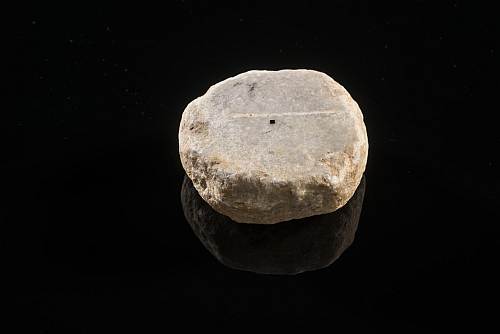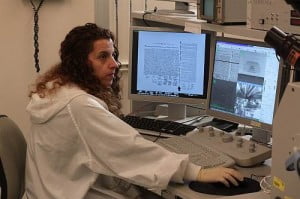US President Barack Obama’s was presented with very special gift from Israeli Prime Minister Benjamin Netanyahu during his landmark visit to Israel. The American president received a 2,000 year-old stone on which the Declarations of Independence of the United States of America and the State of Israel will be etched side-by-side on a silicon chip. The gift embodies two main aspects of Israeli culture – Innovation and heritage.
Related posts
- Israeli Scientists Develop Microscopic Robot That Detects Disease Inside Cells
- Netanyahu Launches Smartphone App For Obama Visit
To prepare this special gift, Netanyahu approached scientists of the Technion’s Russell Berrie Nanotechnology Institute. The scientists etched the historic documents into a gold-coated silicon chip, using a focused beam of high energy gallium ions. The area of the inscription is 0.04 square mm, and it is 20 nanometer, or 0.00002 mm, deep.
The inscription was done by accelerating charged atoms, called ions, and bombarding them at various points on the surface of the chip. When an ion beam hits the chip it creates a tiny crevice, in this case 20 nanometers deep. This is similar to digging tiny holes in the ground using a water jet out of an irrigation hose, except that the holes formed by the researchers are a million times smaller.
Placing state-of-the-art technology on a piece of archeology
Later, the chip was attached to a Jerusalem Stone from the Second Temple Period (1st century BCE to 1st century AD), such as the stones used to seal clay vessels. The silicon chip is coated with a 20 nanometer thick gold film. When the ion beam forms a hole 20 nanometers deep at a certain point on the surface of the chip, it sputters away the gold film, revealing the silicon beneath it. Scanning the chip with an electron microscope shows that the regions where the silicon was exposed are darker than the surrounding gold coated areas.
The preparation work for the etching took about a week. The image etched on the chip contains over two million dots. The ion beam was aimed at the required dots on the chip using a computer, so that the entire engraving process took less than an hour.
Sign up for our free weekly newsletter
SubscribeDuring the engraving the chip was part of a round silicon slice 5 centimeters in diameter and 0.13 millimeters thick. The chip was detached from the slice by chemically corroding the silicon slice around it with an advanced plasma tool.
The original image was translated into etching instructions using a special program developed for this purpose by Dr. Ohad Zohar, who conducted his Ph.D. under Prof. Uri Sivan of the Physics Department. The engraving was done by Dr. Tzipi Cohen-Hyams, in charge of the Focused Ion Beam lab in the Russel Berrie Nanotechnology Institute.
[youtuber youtube=’http://www.youtube.com/watch?v=FVnI9-8N3yw’]
The entire team that took part in the work was comprised of Prof. Wayne D. Kaplan, Dean of the Department of Materials Science and Engineering; Prof. Nir Tessler, Head of the Center for Mircoelectronics and Nanoelectronics; Mr. Yaacov Shneider, Chief Engineer in the Center of Mircoelectronics and Nanoelectronics; Dr. Orna Ternyak, Plasma Senior Engineer in the Micro and Nanofabrication Unit and Ms. Svetlana Yoffis, process engineer in the Micro and Nanofabrication Unit.
Photos: courtesy
Related posts

Editors’ & Readers’ Choice: 10 Favorite NoCamels Articles

Forward Facing: What Does The Future Hold For Israeli High-Tech?

Impact Innovation: Israeli Startups That Could Shape Our Future





Facebook comments